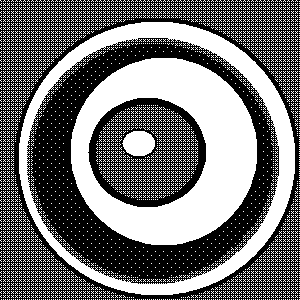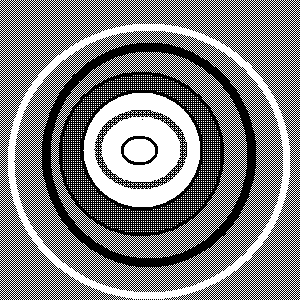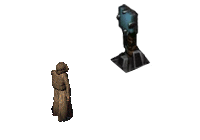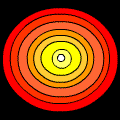

A couple of follow-up comments to last night's Net Aesthetics 2.0* panel.
--Moderator Ed Halter mentioned the term "internet aware art" as an alternative shading of "net art." He attributed the term to Guthrie Lonergan but it had not registered with me before. I put one panelist on the spot asking for an example. Sorry, wasn't trying to be jerk, but was genuinely curious to know what this subgenre might consist of. An example could be Aron Namenwirth's paintings of Hillary Clinton and Osama bin Laden as barely-formed pixelated imagery. You can't look at them without thinking "blurry thumbnail on the Net blown up" but they are not Net Art because they don't use the medium of the web. Guthrie's use of the term, in his interview with Thomas Beard, takes the emphasis away from the Net but also objects (i.e., paintings):
Right now I'm scheming how to take the emphasis off of the Internet and technology, but keep my ideas intact. Objects that aren't objects... I got a couple of books and a t-shirt in the works. Right now I'm really into text (not visually/typography... just... text...), and lots and lots of lists… "Internet Aware Art." :)
This concept could use some elaboration!
--Halter asked whether Internet Art was always minor or slight and if anyone had produced the "long form" equivalent of a novel or opera. I said that a blog over many years could be like a novel but it isn't a novel or read like one--it's a new creature. Ed asked if Internet art could express emotions like sadness. Didn't have time to mention, for example, Guthrie Lonergan's delicious bookmarks tagged "self publishing". Sad might be too dramatic, but there is certainly melancholy in these found book covers for self-published books. The style is below professional design standards but not so low that it becomes entertaining "dirt style." In a way it reflects on all of us who self-publish, we see our own pitiful aspirations reflected in these barely-off-the-ground efforts. To get back to the long form, Travis Hallenbeck's bookmarks have hundreds of examples of "not ready for prime time" art that evoke struggling "little guys" or "lonely girls" right out of Tennessee Williams. The bookmarks alone define the artistic sensibility, there is no self-conscious shaping. YouTube abounds with sad videos and Guthrie has an eye for them and how to put them together. So the answer to the question is an emphatic yes, but because we're talking about a "new medium" here the emotions may not be so apparent as someone in Viking garb singing his heart out with a downcast expression.
Update, 2010: "Internet aware art" continued to be discussed after the panel. Halter and others kept using it to mean "offline art based on online activity" or some such and pointing to Lonergan's quote above as the source of the concept. Lonergan has since clarified that he was (i) being sarcastic, as in "who's not aware of the internet?" and/or (ii) thinking more about people who make things off line with an eye to how they will ultimately look on the web (i.e., internet-ready, a la Vvork.com).
*Update, 2011: The Rhizome link has been changed to http://rhizome.org/editorial/2008/jun/2/net-aesthetics-20/

These are some issues to be discussed at the Net Aesthetics panel tonight, emailed around by moderator Ed Halter. These questions will be divvied among specific artists to get the conversational ball rolling but I have "answered" some of them here.
- What is the relationship of internet art now to contemporary art as a whole? Can internet art work in a gallery setting? Has this relationship changed over time?
Whether internet art can work in the gallery setting: see BLOG, the exhibition.
- What are the boundaries between internet art and other cultural production online—creative memes, design, “digital folk culture”—and how important are these distinctions between art and non-art online?
See my panel "notes."
- Contemporary discussions of internet culture now stress the concept of the “wisdom of crowds”--the idea that the true creative power of the internet is collective, not individual. How does this relate to the idea of individual artistic production, or the phenomenon of surfing clubs?
"The ego in the egalitarian"
- Is there a dearth of political content to contemporary internet art? If so, does this mean we’re in a more “formalist” period?
Glad formalist is in scare quotes. I don't believe formalist is the opposite of political.
- Internet art today often feels “minor” in its mode—momentary, ephemeral, and attuned to elements like satire, parody, historical referencing, rather than grand statements. So, can internet art (by its nature perhaps) produce a “major”, longform work of art? What would be the online equivalent of the novel, the symphony, the epic poem?

Tomorrow, Friday, June 6, at 7 pm at the New Museum, please join me for:
The upcoming program in Rhizome's New Silent Series at the New Museum, Net Aesthetics 2.0, will examine the state of contemporary art engaged with internet art. Convening leading artists, critics and curators, this panel will explore salient topics such as the relationship of artists emerging now to the first generation of internet art, the correspondence between online art and offline exhibition (as well as the phenomenon of "internet aware" art), the current role of the artist on the internet, the position of explicit political content in internet art (and the question of whether internet art practice is undergoing a more "formalist" phase), among other directions and challenges faced by this expansive field.
This talk will be the second in a series of Net Aesthetics 2.0 events. Panelists include artists Petra Cortright, Jennifer and Kevin Mccoy, Tom Moody, Tim Whidden and Damon Zucconi and will be moderated by curator, critic and Rhizome staff writer Ed Halter. Tickets available here.
Friday June 6th, 7:30pm
the New Museum, New York, NY
$8 general public, $6 Members (Rhizome and New Museum)
Presented in conjunction with Internet Week
The GIF above is a found animation that looks sort of like things I've made.
*Update, 2011: The Rhizome link has been changed to http://rhizome.org/editorial/2008/jun/2/net-aesthetics-20/